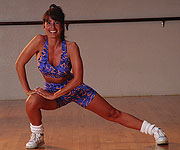
TUESDAY, Dec. 14 (HealthDay News) — People who consistently exercise during their younger years, especially women, are less likely to face the battle of the bulge that less-consistent types struggle with, researchers say.
But regular exercise while young only appeared to prevent later weight gain if it reached about 150 minutes of moderate to vigorous physical activity a week, such as running, fast walking, basketball, exercise classes or daily activities like housework, according to a study in the Dec. 15 issue of the Journal of the American Medical Association.
This is the amount of physical activity recommended by the U.S. Department of Health and Human Services.
“This encourages people to stick with their active lifestyle and a program of activity over decades,” said study lead author Dr. Arlene L. Hankinson, an instructor in the department of preventive medicine at Northwestern University’s Feinberg School of Medicine in Chicago, noting that the study covered 20 years.
“It’s important to start young and to stay active but that doesn’t mean you can’t change. It just may be harder to keep the weight off when you get to be middle-aged,” said Marcia G. Ory, a Regents professor of social and behavioral health and director of the Aging and Health Promotion Program at Texas A&M Health Science Center School of Rural Public Health in College Station, Texas.
Most of today’s research focuses on losing weight, not preventing weight gain in the first place, Hankinson said.
To investigate the latter, this study followed 3,554 men and women aged 18 to 30 at the start of the study, for 20 years. Participants lived in one of four urban areas in the United States: Chicago, Illinois; Birmingham, Alabama; Minneapolis, Minnesota; and Oakland, California.
After adjusting for various factors such as age and energy intake, men who maintained a high activity level gained an average of 5.7 fewer pounds and women with a high activity level put on 13.4 fewer pounds than their counterparts who exercised less or who didn’t exercise consistently over the 20-year period.
Much of that benefit was seen around the waist, with high-activity men gaining 3.1 fewer centimeters (1.2 inches) around the gut each year and women 3.8 fewer centimeters (1.5 inches) per year.
The researchers cautioned that higher levels of physical activity alone may not be entirely sufficient to keep off weight, however, noting that men and women at all activity levels gained weight over the 20-year period. Nonetheless, they noted, higher activity certainly helped hold down weight during the transition from youth to middle age.
The 20-year follow-up in this study was particularly impressive, Ory noted, especially given that most weight-focused studies these days are shorter term.
“You can track [weight] at key decision points — what kinds of activities do they do in a reliable manner and what difference it makes,” she said.
The gender difference (the magnitude of the benefit was double in women than in men) could be explained by physiological differences, the researchers suggested.
“The two physiological things that are associated with female gender that definitely play a role are having children and menopause,” Hankinson said. “But there could be other physiologic differences we can’t measure, and there may also be cultural differences.”
“We know that for women who are going through menopause, there’s this natural increase in weight gain,” added Dr. Suzanne Steinbaum, director of women and heart disease at Lenox Hill Hospital in New York City. “My comment also is to train for menopause as if you’re training for a marathon. If you start exercising before menopause hits and do that for 20 years, you don’t have to gain weight. Health isn’t about flipping a switch. It’s about maintaining a lifestyle.”
“Let’s go into middle age with the best opportunities we have for good weight, and you do that by starting early,” Ory agreed. “But it’s never too late to start good behaviors. You’re just probably going to have to do it more intensively.”
More information
The U.S. Department of Health and Human Services has guidelines on physical activity.

